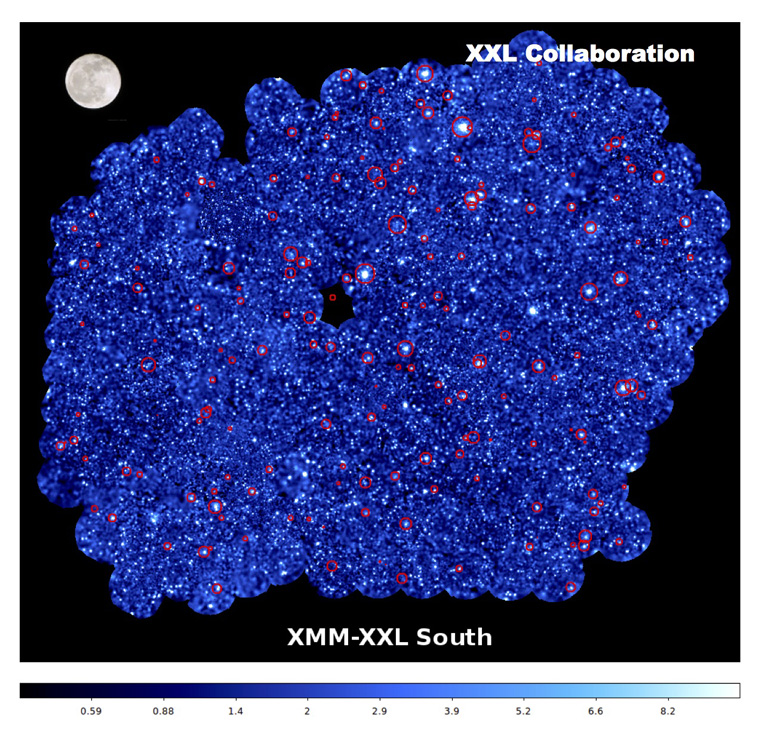The XXL Survey: First results
XXL is a large survey of the X-ray sky with the XMM-Newton ESA observatory. Its goal is to detect a few hundreds of clusters at a look-back time when the age of the Universe was about half its present value (z~1). DARK Fellow, David Rapetti is among the international team releasing their results for the first time.
Scientific goals of the XXL
The way matter is distributed in the universe has a history: small density perturbations present at the time of Recombination (just after the CMB was emitted) grew under the competing actions of gravity and expansion of the space-time.
This led to the progressive formation of a remarkable network of filaments, sheets and voids that has been first enlightened by the galaxy distribution some 30 years ago and is now well rendered by numerical simulations. We find clusters of galaxies, the most massive objects in the universe, located at the nodes of the cosmic web and are huge reservoirs of hot gas that fills the space between the galaxies. The gas has a temperature of a few tens of millions degrees and shines in X-ray.

XMM image of field XXL-S. The two 25 deg2 fields of XXL are covered by some 540 XMM pointings. The XMM field of view is comparable to the size of the Moon (30’ diameter). Over 12000 AGNs are detected in this image. The red circles show the clusters of galaxies. Along with field XXL-N, XXL-S is, by far, the largest view of the deep X-ray sky obtained to date. (XXL Collaboration, S. Snowden, L. Facciolo, F. Pacaud).
In this context, the XXL project[1] undertook a large survey of the X-ray sky with the ESA observatory XMM- Newton. The goal is to detect a few hundreds of clusters back to a time when the age of universe was about half of its present value (z~1). From this, astronomers can infer the evolutionary properties and spatial distribution of the deepest potential wells of the universe and, subsequently, test various cosmological scenarios.
The first series of XXL articles
Two years after the completion of the XMM observations, some 450 clusters and 25,000 AGNs have been detected in the XXL survey. In a first series of 13 articles published in a December 15, 2015 A&A special issue, the catalogues of the brightest 100 clusters and 1000 AGNs are released, as well as the reduced XMM observations. A number of scientific results to date are discussed, including the little explored low-mass range characterising the XXL cluster sample.
The next coming cosmological analysis of the full XXL cluster sample (2017) will involve a complete self-consistent treatment of the cluster evolution and selection function. With some five times as many clusters, the final sample will enable better constraints on cluster physics, hence providing mass estimates at the level required for precision cosmology.
Associated multi-lambda programme
In order to characterise the properties of the detected clusters and AGNs, the XXL survey is accompanied by a comprehensive follow-up programme[2]. Observations are coordinated with the largest ground-based and space observatories, from the X-ray to the radio wavebands. Of these, the ESO Large Programme (2013-2015) is of special relevance as it allows us to measure the cluster redshifts, hence to locate the clusters in the 3D space.
In parallel, four numerical simulation programmes provide the necessary material to test ‘in situ’ the various physical mechanisms that drive cluster and AGN evolution and their respective interactions. Simulations also allow an accurate determination of the cluster selection function, which is an essential ingredient of the cosmological analysis.
The XXL science team
XXL is an international project based around an XMM Very Large Programme surveying two 25 deg2 extragalactic fields at a depth of ~5 x 10-15 erg cm-2 s-1 in the [0.5-2] keV band for point-like sources. The XXL website is http://irfu.cea.fr/xxl .
Multi-band information and spectroscopic follow-up of the X-ray sources are obtained through a number of survey programmes, summarised at http://xxlmultiwave.pbworks.com/.
The XXL consortium gathers some 100 scientists from all over the world[3]. This team of observers, theoreticians and simulators has a wide range of expertise encompassing the entire electromagnetic spectrum. XXL is associated to the GAMA and VIPERS projects.
Contact:
David Rapetti, rapetti@dark-cosmology.dk
